Florida Butterflies
Zebra Longwing, Monarch, Zebra Swallowtail, Giant Swallowtail, Spicebush Swallowtail, Eastern Tiger Swallowtail, Eastern Black Swallowtail, Pipevine Swallowtail, Gulf Fritillary, Queen
Zebra Longwing Butterfly - Heliconius charitonius
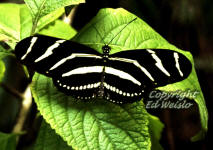
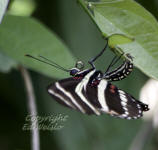
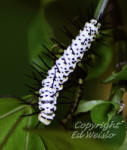
The designated Florida state butterfly, the Zebra longwing has long, narrow wings with distinctive black and pale yellow stripes, no other butterflies in Florida have a similar pattern, it also flies in a slow graceful manner. Found throughout Florida they are most abundant in South Florida.
The Zebra Longwing butterfly is unique in that it is able to feed on a flowers pollen as well as the nectar, this is an excellent source of protein and scientists attribute their relatively long life span of 3-4 month to this diet, compared to most other butterflies with a 2-6 week lifespan.
Zebra longwing begins laying eggs shortly after emerging from the chrysalis and will lay from 5 to 15 pinhead sized eggs on Passion vines, the larval host plant for this beautiful butterfly. Larvae absorb toxins from the vine, giving them and the adults an unpleasant taste to predators.
Zebra longwing butterflies are fairly common throughout Florida and is most abundant in South Florida hardwood hammocks and thickets, adults will often group together in a quiet spot to roost for the night.
Monarch Butterfly - Danaus plexippus
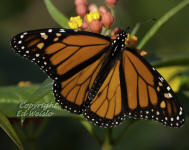
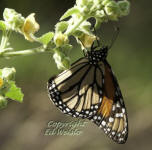
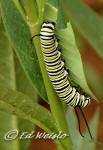
The Monarch has a wingspan of 3 to 4 inches, males, pictured at the top above, have a black dot on their hind wings above a vein, these are scent scales that release pheromones to attract females.
The Monarch may be the most widely recognized butterfly in North America, this beautiful insect is known for its vivid orange and black markings as well as for its long distance migration. Each fall Monarchs head south to the mountains of central Mexico where they overwinter, the following summer (and 3 or 4 generations later) they make a return trip back to the United States and Canada.
Also called the Milkweed butterfly because they use only Milkweed plants as larval host plants, this butterfly stores the plants toxins in its body as a defense against predators. Adult Monarchs can live to be a ripe old age of 6 to 8 months during their migration to Mexico and subsequent hibernation, compare this to 2 to 6 weeks for the average butterfly lifespan.
Zebra Swallowtail Butterfly - Eurytides marcellus
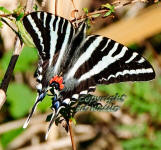
The Zebra Swallowtail has a wingspan of 2 1/2 - 4 inches and is Florida's only native kite swallowtail. Wings are white striped with black, hind wings have long tails.
Zebra swallowtails use only the young leaves of shrubs of the genus Asimina or Paw-paw for larval host plants, this makes them especially vulnerable to habitat loss or fragmentation. Can be seen from March through December in Florida. Uses moist, low lying woodlands for breeding, adults feed on a variety of wildflowers.
Spicebush Swallowtail - Papilio troilus (ilioneus)
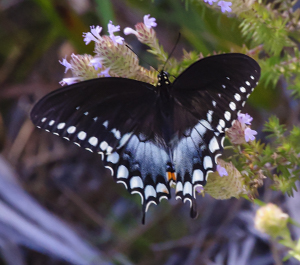
Inhabits all of the Florida peninsula, except south of the the Miami area and Keys.
Wingspan of 3 to 4.78 inches, in Florida there are several flights ( generations) between March-December. Upper surface of fore-wing is mostly black with pale spots along its margin.
Upper surface of hind-wing has orange spot on costal margin with bluish scales on females, more bluish-green on males. Underside of hindwings with pale green marginal spots.
Eastern Black Swallowtail - Papilio polyxenes
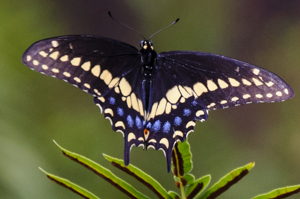
Wingspan - 3 1/4 - 4 1/4 inches, 3 or more flights per year in Florida.
Dorsal surface of wings mostly black, the inner edge of hindwings has an orange spot with a black center. Male has yellow band near edge of wings; female hasa row of yellow spots. Female hindwings with iridescent blue band.
Host plants in the parsley family (Apiaceae) including fennel, carrot, celery and dill, and members of the citrus (Rutaceae) family. Adults nectar from flowers of red clover, milkweeds and thistles.
Pipevine Swallowtail - Battus philenor
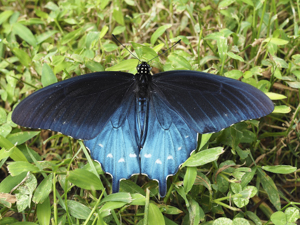
Wingspan of 2 3/4 to 5 inches. Unfortunately, this pretty butterfly's native range extends southward only through the northern half of Florida. Larval hosts are plants belonging to the genus Aristolochia, (Pipevine, Dutchman's Pipe) to which their common name refers.
The dorsal, or upper surfaces of the males wings are mostly black with bright blue or blue-green iridescence on the hind wings, females hind wings are also slightly bluish, although much paler than the males. There are light marginal and sub-marginal spots on both forewings and hindwings as well as white lateral spots on the abdomen.
Eastern Tiger Swallowtail - Papilio glaucus
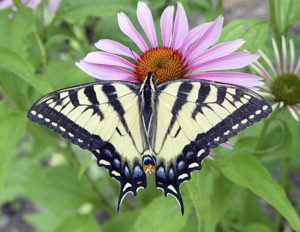
Wingspan is from 3 to 5 1/2/ inches. Males are yellow with four black bands on the forewings, the outer edge of the fore-wing is black with a row of yellow spots and black veins. The post-median area of the hindwings is black with yellow spots on the lower margin and small red and blue spots on the inner margin. The ventral fore-wing margin has a yellow bar that is broken into spots.
Females are dimorphic having a morph with black or grey replacing the yellow on the wings, darker bands may still be visible.
This large butterfly produces at least three and possibly four flights in Florida (Scriber 1996) beginning in late February or March. Common host plants are those of the families Magnoliaceae and Rosaceae.
Sweetbay magnolia, (Magnolia virginianais) is a major host plant in Florida. Adults feed on a wide variety of flowers. Sipping water and minerals from mud, males often conglamorate in a characteristic called "puddling" (Berger and Lederhouse 1985).
Giant Swallowtail - Papilio cresphontes
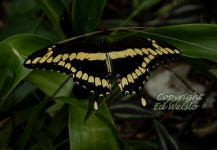
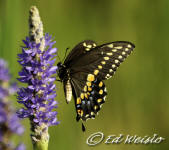
The Giant swallowtail butterfly has a wingspan of 4 to 6+ inches and is black on the upper surface, with a distinctive band of yellow spots across the forewings and the trailing edge of the hind wings, the tails are yellow with black edges.
Caterpillar host plants are members of the family Rutaceae including citrus and prickly ash trees (Zanthoxylum americanum).
Larva are called "Orange dogs" and resemble bird droppings. The Giant swallowtail can be seen year round in Florida, adults feed on nectar from a variety of plants including Lantana, Azalea, Goldenrod and Swamp milkweed.
Gulf Fritillary - Agraulis vanillae
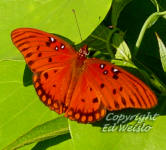
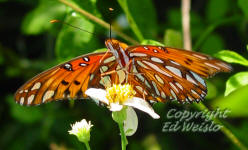
Found throughout South Florida the year round, the Gulf Fritillary is bright orange with black markings on the top side and 3 white dots at the leading edge of the forewings. The ventral surface of the wings is brownish orange with elongated iridescent silver spots.
This butterfly has a 2 1/2 to 3 3/4 inch,(95 mm) wingspan, and uses Passiflora incarnata L and several other Passionflower vines as a larval host plants. The caterpillar is around 1 1/2 inches long and is orange with black, forked spines.
Adults feed on various flowers including Lantana and Sheppard's needle and frequent butterfly gardens, fields, roadsides and open woods.
Large numbers of Gulf Fritillary move from the northern reaches of their range into peninsular Florida in late summer and throughout the fall, returning northward in spring.
Queen Butterfly - Danaus gilippus
2_small.jpg)
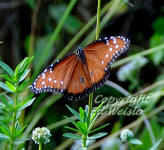
The upper side of the Queen butterfly is a chestnut brown color, forewings have black borders with two rows of white spots with a cluster of white spots at the wing tips. Males (photo at lower left) have a black spot on the hind wings, this cluster of dark scales emit pheromones to help attract females. Wing span is from about 2 1/2 to 4 inches.
Caterpillar host plants include the Milkweeds and Milkweed vines. These plants lend a heart and nervous system toxin to the larva and adult butterflies, any predator that tries to feed on a Queen butterfly is unlikely to try again.
Adults feed on a variety of flowers including milkweeds, frequenting the open sunny areas of woods and yards throughout Florida.